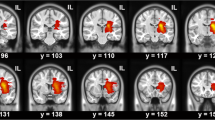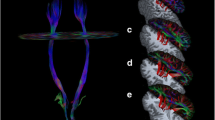Abstract
Diffusion tensor MR imaging (DTI) provides information on diffusion anisotropy, which can be expressed with three-dimensional (3D) white matter tractography. We used 3D white matter tractography to show the corticospinal tract in eight patients with acute or early subacute ischaemic stroke involving the posterior limb of the internal capsule or corona radiata and to assess involvement of the tract. Infarcts and the tract were shown simultaneously, providing information on their spatial relationships. In five of the eight patients, 3D fibre tract maps showed the corticospinal tract in close proximity to the infarct but not to pass through it. All these patients recovered well, with maximum improvement from the lowest score on manual muscle testing (MMT) up to the full score through rehabilitation. In the other three patients the corticospinal tract was shown running through the infarct; reduction in MMT did not necessarily improve favourably or last longer, other than in one patient. As 3D white matter tractography can show spatial relationships between the corticospinal tract and an infarct, it might be helpful in prognosis of gross motor function.


Similar content being viewed by others
References
Basser PJ, Pierpaoli C (1996) Microstructural and physiological features of tissues elucidated by quantitative-diffusion-tensor MRI. J Magn Reson B 111: 209–219
Conturo TE, McKinstry RC, Akbudak E, Robinson BH (1996) Encoding of anisotropic diffusion with tetrahedral gradients: a general mathematical diffusion formalism and experimental results. Magn Reson Med 35: 399–412
Melhem ER, Mori S, Mukundan G, et al (2002) Diffusion tensor MR imaging of the brain and white matter tractography. Am J Roentgenol 178: 3–16
Sorensen AG, Wu O, Copen WA, et al (1999) Human acute cerebral ischemia: detection of changes in water diffusion anisotropy by using MR imaging. Radiology 212: 785–792
Shimony JS, McKinstry RC, Akbudak E, et al (1999) Quantitative diffusion-tensor anisotropy brain MR imaging: normative human data and anatomic analysis. Radiology 212: 770–784
Masutani Y, Abe O, Aoki S, et al (2002) Tractography of brain white matter tracts based on analysis of MR diffusion tensor data: selective tractography with tracking reliability. Med Imag Tech 20: 584–592 [Japanese]
Yagishita A, Nakano I, Oda M, Hirano A (1994) Location of the corticospinal tract in the internal capsule at MR imaging. Radiology 191: 455–460
Iwasaki S, Nakagawa H, Fukusumi A, et al (1991) Identification of pre- and postcentral gyri on CT and MR images on the basis of the medullary pattern of cerebral white matter. Radiology 179: 207–213
Victor M, Ropper AH (2001) Principles of neurology. McGraw-Hill, New York, pp 47–66
Mori S, Frederiksen K, van Zijl PC, et al (2002) Brain white matter anatomy of tumor patients evaluated with diffusion tensor imaging. Ann Neurol 51: 377–380
Victor M and Ropper AH (2001) Principles of neurology. McGraw-Hill, New York, pp 821-924
Miyabe M, Mori S, van Zijl PC, et al (1996) Correlation of the average water diffusion constant with cerebral blood flow and ischemic damage after transient middle cerebral artery occlusion in cats. J Cereb Blood Flow Metab 16: 881–891
Fiehler J, Foth M, Kucinski T, et al (2002) Severe ADC decreases do not predict irreversible tissue damage in humans. Stroke 33: 79–86
Wiegell MR, Larsson HB, Wedeen VJ (2000) Fiber crossing in human brain depicted with diffusion tensor MR imaging. Radiology 217: 897–903
Acknowledgements
We thank K. Ino and Y. Satake for technical advice on image processing.
Author information
Authors and Affiliations
Corresponding author
Rights and permissions
About this article
Cite this article
Kunimatsu, A., Aoki, S., Masutani, Y. et al. Three-dimensional white matter tractography by diffusion tensor imaging in ischaemic stroke involving the corticospinal tract. Neuroradiology 45, 532–535 (2003). https://doi.org/10.1007/s00234-003-0974-4
Received:
Accepted:
Published:
Issue Date:
DOI: https://doi.org/10.1007/s00234-003-0974-4




